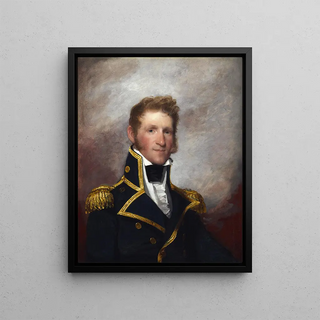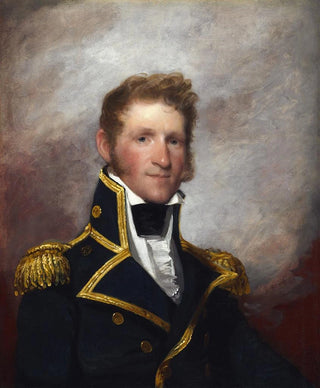Art print | Commodore Thomas Macdonough - Gilbert Stuart


View from behind

Frame (optional)
Gilbert Stuart's art print "Commodore Thomas Macdonough" is much more than a simple portrait; it embodies the very essence of an era when the young American nation sought to forge its identity. Created in the early 19th century, this piece immortalizes a hero of the War of 1812, a man whose leadership and courage left a lasting impression. Through this representation, Stuart not only captures the physical appearance of the commodore but also conveys an impression of dignity and determination. The art print serves as a window into the past, offering viewers an invitation to explore the military and political history of the United States, while celebrating the spirit of its iconic figures.
Style and uniqueness of the art print
Gilbert Stuart's style is recognizable by its ability to blend realism and idealization. In "Commodore Thomas Macdonough," he uses a palette of rich colors and subtle light effects to emphasize the features of the commodore's face, giving him an almost heroic aura. The composition is carefully orchestrated, with a dark background that highlights the brightness of the main figure. This stylistic choice is deliberate; it aims to direct the viewer's gaze toward the face of the commodore, a symbol of bravery and patriotism. The meticulous details, from the folds of the uniform to facial expressions, demonstrate a keen attention to detail that characterizes Stuart's work. Every brushstroke seems to tell a story, making this art print a masterpiece of American painting.
The artist and his influence
Gilbert Stuart, born in 1755, is often regarded as one of the greatest American portraitists. His work marked a turning point in the history of art in the United States, helping to establish a national style that combines European influences with American themes. Stuart was able to capture not only the appearance of his subjects but also their character, aspirations, and place in history. His influence extends far beyond his era; he paved the way for many artists who followed, demonstrating the importance of national identity in art. "Commodore Thomas Macdonough" is a perfect example of this approach, where the portrait becomes a means of celebrating and preserving

Matte finish

View from behind

Frame (optional)
Gilbert Stuart's art print "Commodore Thomas Macdonough" is much more than a simple portrait; it embodies the very essence of an era when the young American nation sought to forge its identity. Created in the early 19th century, this piece immortalizes a hero of the War of 1812, a man whose leadership and courage left a lasting impression. Through this representation, Stuart not only captures the physical appearance of the commodore but also conveys an impression of dignity and determination. The art print serves as a window into the past, offering viewers an invitation to explore the military and political history of the United States, while celebrating the spirit of its iconic figures.
Style and uniqueness of the art print
Gilbert Stuart's style is recognizable by its ability to blend realism and idealization. In "Commodore Thomas Macdonough," he uses a palette of rich colors and subtle light effects to emphasize the features of the commodore's face, giving him an almost heroic aura. The composition is carefully orchestrated, with a dark background that highlights the brightness of the main figure. This stylistic choice is deliberate; it aims to direct the viewer's gaze toward the face of the commodore, a symbol of bravery and patriotism. The meticulous details, from the folds of the uniform to facial expressions, demonstrate a keen attention to detail that characterizes Stuart's work. Every brushstroke seems to tell a story, making this art print a masterpiece of American painting.
The artist and his influence
Gilbert Stuart, born in 1755, is often regarded as one of the greatest American portraitists. His work marked a turning point in the history of art in the United States, helping to establish a national style that combines European influences with American themes. Stuart was able to capture not only the appearance of his subjects but also their character, aspirations, and place in history. His influence extends far beyond his era; he paved the way for many artists who followed, demonstrating the importance of national identity in art. "Commodore Thomas Macdonough" is a perfect example of this approach, where the portrait becomes a means of celebrating and preserving






